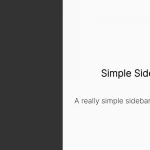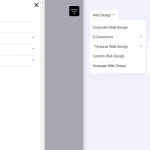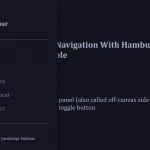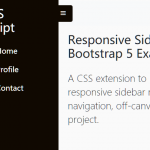| Author: | svinkle |
|---|---|
| Views Total: | 6,347 views |
| Official Page: | Go to website |
| Last Update: | June 15, 2014 |
| License: | MIT |
Preview:

Description:
In this post we’re going to create a mobile app-style off-canvas menu that will slide out from the edge of your screen and push the main content to the right. No Javascript (jQuery) needed.
How to use it:
Create an off-canvas navigation menu using Html unordered list.
<nav class="site-menu">
<h2>Menu</h2>
<ul>
<li>List Item 1</li>
<li>List Item 2</li>
<li>List Item 3</li>
</ul>
</nav>Create links to open and close the off-canvas menu.
<a href="#site-canvas" class="toggle-nav">≡</a> <a href="#" class="close-canvas"></a>
Insert other contents into the Html document. The full Html should be like this.
<div class="site-wrapper">
<div class="site-canvas" id="site-canvas">
<nav class="site-menu">
<h2>Menu</h2>
<ul>
<li>List Item 1</li>
<li>List Item 2</li>
<li>List Item 3</li>
</ul>
</nav>
<div class="site-content">
<header class="header"> <a href="#site-canvas" class="toggle-nav">≡</a>
<h1>Off-Canvas Menu with Pure CSS</h1>
</header>
<div class="content">
Your Main Content Goese Here
</div>
</div>
<a href="#" class="close-canvas"></a> </div>
</div>The required CSS/CSS3 styles to enable the off-canvas menu. Tweak the CSS or add your own styles as you wish.
.site-wrapper {
height: 800px; /* Temp */
overflow: hidden;
position: relative;
width: 100%;
}
.site-canvas {
height: 100%;
position: relative;
width: 100%;
-webkit-transform: translateX(0);
-moz-transform: translateX(0);
-ms-transform: translateX(0);
-o-transform: translateX(0);
transform: translateX(0);
-webkit-transform: translate3d(0, 0, 0);
-moz-transform: translate3d(0, 0, 0);
-ms-transform: translate3d(0, 0, 0);
-o-transform: translate3d(0, 0, 0);
transform: translate3d(0, 0, 0);
-webkit-transition: 300ms ease all;
-moz-transition: 300ms ease all;
-ms-transition: 300ms ease all;
-o-transition: 300ms ease all;
transition: 300ms ease all;
-webkit-backface-visibility: hidden;
-moz-backface-visibility: hidden;
-ms-backface-visibility: hidden;
-o-backface-visibility: hidden;
backface-visibility: hidden;
}
.site-canvas--active,
#site-canvas:target {
-webkit-transform: translateX(300px);
-moz-transform: translateX(300px);
-ms-transform: translateX(300px);
-o-transform: translateX(300px);
transform: translateX(300px);
-webkit-transform: translate3d(300px, 0, 0);
-moz-transform: translate3d(300px, 0, 0);
-ms-transform: translate3d(300px, 0, 0);
-o-transform: translate3d(300px, 0, 0);
transform: translate3d(300px, 0, 0);
}
.site-menu {
background: #e74c3c;
color: White;
height: 100%;
left: -300px;
padding: 15px;
position: absolute;
top: 0;
width: 300px;
-webkit-box-sizing: border-box;
-moz-box-sizing: border-box;
-ms-box-sizing: border-box;
-o-box-sizing: border-box;
box-sizing: border-box;
}
.site-content { position: relative; }
.close-canvas {
background-color: transparent;
bottom: 0;
cursor: pointer;
display: none;
height: 100%;
left: 0;
position: absolute;
right: 0;
top: 0;
width: 100%;
}
#site-canvas:target .close-canvas { display: block; }
/* Extra... */
a { color: CornflowerBlue; }
.header {
background-color: #2c3e50;
padding: 15px;
position: relative;
}
.header a {
color: White;
text-decoration: none;
}
.toggle-nav {
font-size: 2.8em;
left: .3em;
margin-top: -.7em;
position: absolute;
top: 50%;
}
h1 {
color: White;
margin: 0;
padding-left: 1em;
}
.content { padding: 15px; }










how could I implement this in an angularjs app?
I’m having trouble understaing the mechanism. how do I check the button click withtout javascript at all?